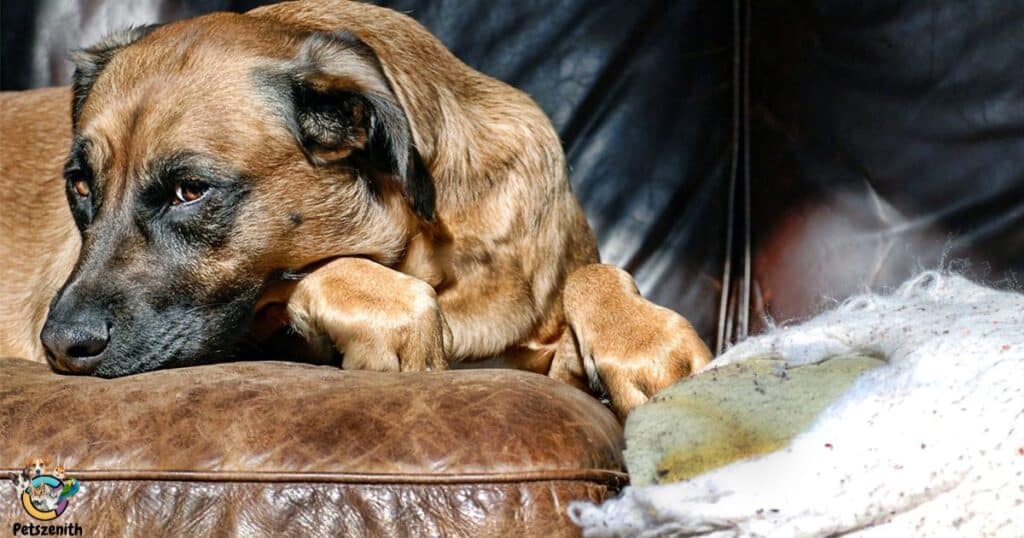Crate training a rescue dog with separation anxiety is a crucial step in helping them adjust to their new home. This process provides a safe space for them to feel secure and calm when left alone. By following effective crate training techniques, you can alleviate their anxiety and prevent destructive behaviors. Let’s explore how to crate train a rescue dog with separation anxiety.
Looking to ease your rescue dog’s separation anxiety. Learn how to crate train a rescue dog with separation anxiety. Crate training provides security and comfort, helping your dog feel safe when you’re away. Effective techniques to crate train and support your furry friend through their anxiety.
Identify Their Triggers
Identifying triggers is essential when crate training a rescue dog with separation anxiety. Observe your dog’s behavior to pinpoint specific situations or stimuli that cause distress. Common triggers may include certain noises, departures, or changes in routine. Once you identify these triggers, you can develop strategies to address them and make the crate training process more effective for your furry friend.
Break The Anxious Cycle
Breaking the anxious cycle is crucial in helping your rescue dog overcome separation anxiety. Start by implementing gradual departures and returns to the crate, building trust and confidence. Use desensitization techniques to reduce anxiety triggers and create a calm environment. With consistent training and positive reinforcement, you can break the anxious cycle and promote a sense of security for your furry friend.
Crate Them
Crate them refers to placing your rescue dog inside the crate as part of crate training. This step helps your dog become accustomed to the crate environment and establishes it as a safe space. When crating your dog, ensure it’s a positive experience with treats and toys, reinforcing the crate as a comfortable retreat.
Create And Stick To A Routine
Creating and sticking to a routine is crucial when crate training a rescue dog with separation anxiety. Consistency helps your dog feel secure and understand what to expect. Establish set times for meals, bathroom breaks, and crate sessions. By following a consistent routine, you can reinforce positive behaviors and ease your dog’s anxiety effectively.
Related Post: RESCUE POODLES AND DOODLES IN SHELTERS
Can Crate Training Help With Separation Anxiety?
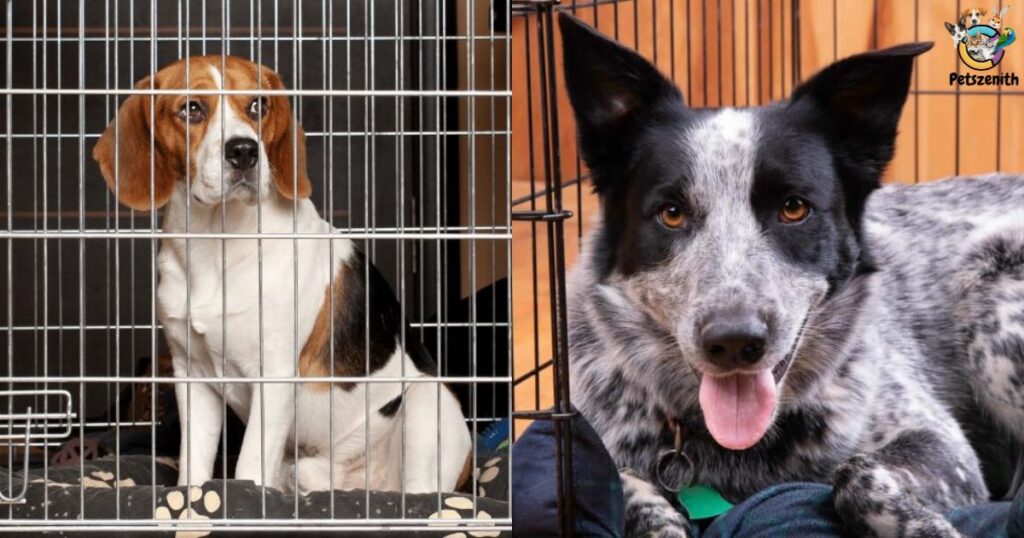
Wondering if crate training can alleviate separation anxiety in your dog. Crate training offers a potential solution by providing a secure and comforting environment for your furry friend. Through gradual introduction and positive reinforcement, crate training can help ease your dog’s anxiety when left alone. Discover how crate training may benefit your dog’s separation anxiety today.
Size
When crate training a rescue dog with separation anxiety, size matters. Choose a crate that allows your dog to stand, turn around, and lie down comfortably. The right size crate provides a cozy environment, promoting a sense of security for your furry friend.
Plastic vs. Metal
It comes to crate options for your rescue dog, you’ll encounter the choice between plastic and metal crates. Plastic crates offer a cozy, den-like feel, while metal crates provide more visibility and airflow. Consider your dog’s preferences and needs to make the best choice for their comfort and safety.
Metal Crate
When considering crate options for crate training a rescue dog with separation anxiety, a metal crate is a sturdy and durable choice. Metal crates provide security and ventilation, making them suitable for dogs prone to anxiety. Their open design allows for visibility, helping your dog feel less confined. Explore the benefits of a metal crate for your rescue dog’s comfort and security during crate training.
Plastic Crate
Plastic crates provide a cozy and den-like environment that can help calm anxious dogs. They’re also durable and easy to clean, making them a practical choice for training. Introduce the plastic crate gradually, ensuring your dog feels comfortable and secure inside. With proper acclimation, your rescue dog can benefit from the security and comfort of a plastic crate during crate training.
How Many Crates
When it comes to crate training a rescue dog with separation anxiety, you might wonder, “How many crates do I need?” Generally, it’s best to have one crate for each location your dog spends significant time in. This ensures they have a familiar space wherever they are, helping to ease their anxiety.
Setting up a Crate for a Rescue Dog with Separation Anxiety
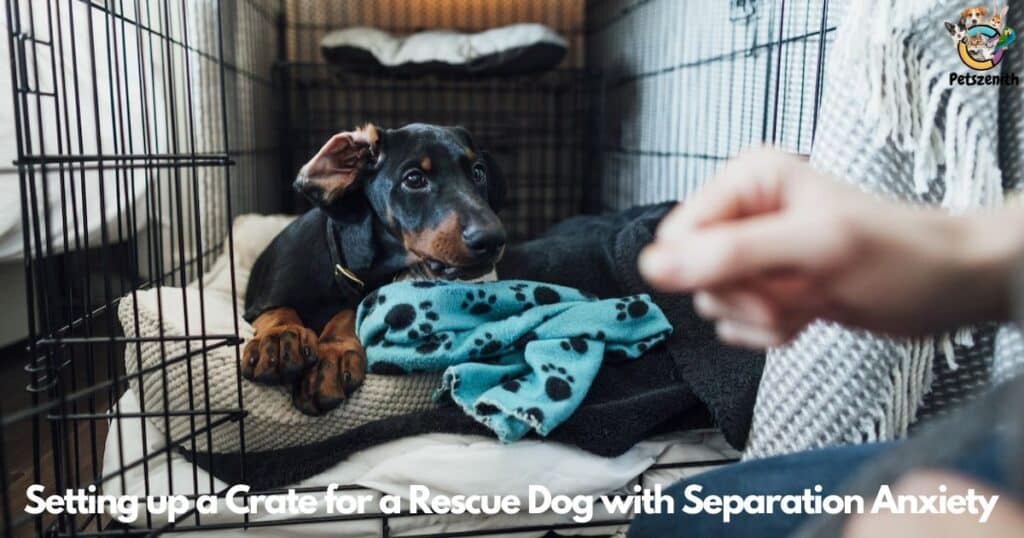
Setting up a crate for a rescue dog with separation anxiety requires careful consideration. Begin by choosing a suitable location that’s quiet and away from distractions. Add comfortable bedding and familiar items to make the crate inviting. Incorporate calming scents and soothing sounds to create a positive environment. Introduce the crate gradually, using treats and praise to encourage your dog’s acceptance. By setting up the crate thoughtfully, you can help your rescue dog feel secure and comfortable during times of separation.
Bedding
Bedding is an essential component of your dog’s comfort and well-being. Providing cozy bedding ensures your furry friend has a soft and supportive surface to rest on. From plush blankets to orthopedic mattresses, there are various options to suit your dog’s preferences and needs. Quality bedding promotes better sleep and overall health for your beloved pet.
Sounds
Creating a soothing environment for your rescue dog’s crate includes incorporating calming sounds. Soft music or white noise can help mask outside disturbances and promote relaxation. Experiment with different sounds to find what works best for your dog. By incorporating calming sounds into crate time, you can further support your dog’s journey to overcoming separation anxiety.
Toys
Toys play a crucial role in crate training a rescue dog with separation anxiety. Choose toys that provide mental stimulation and comfort, such as chew toys or interactive puzzles. These toys can help distract your dog and alleviate anxiety when they’re in the crate. Introducing toys gradually and rotating them regularly can keep your dog engaged and content while in confinement.
Scents
Utilize calming scents during crate training to help soothe your rescue dog’s separation anxiety. Lavender or chamomile scents can create a relaxing atmosphere in the crate. Simply place a few drops of essential oil on a cloth or use a diffuser nearby. These scents can help your dog feel more at ease and comfortable in their crate, promoting successful training outcomes.
Calming Jackets or Vests
Calming jackets or vests are a helpful tool for anxious dogs. Designed to provide gentle pressure, they mimic the feeling of being hugged, promoting relaxation. These jackets can be beneficial during stressful situations like thunderstorms or fireworks. Consider using a calming jacket to help your dog feel more secure and calm.
Camera
Integrating a camera into your crate training routine offers valuable insights into your dog’s behavior while you’re away. By monitoring your dog remotely, you can assess their progress and adjust your training approach as needed. Discover the benefits of using a camera to enhance your crate training experience and support your rescue dog’s journey to overcome separation anxiety.
Choosing the Right Crate for My Dog?
When selecting a crate for your dog, consider their size, breed, and behavior. Opt for a crate that allows them to stand, turn around, and lie down comfortably. Wire and plastic crates are popular options, each with its benefits. Choose the crate style that best suits your dog’s needs and preferences for a comfortable and secure crate-training experience.
How can I manage my dog’s separation anxiety when I am away?
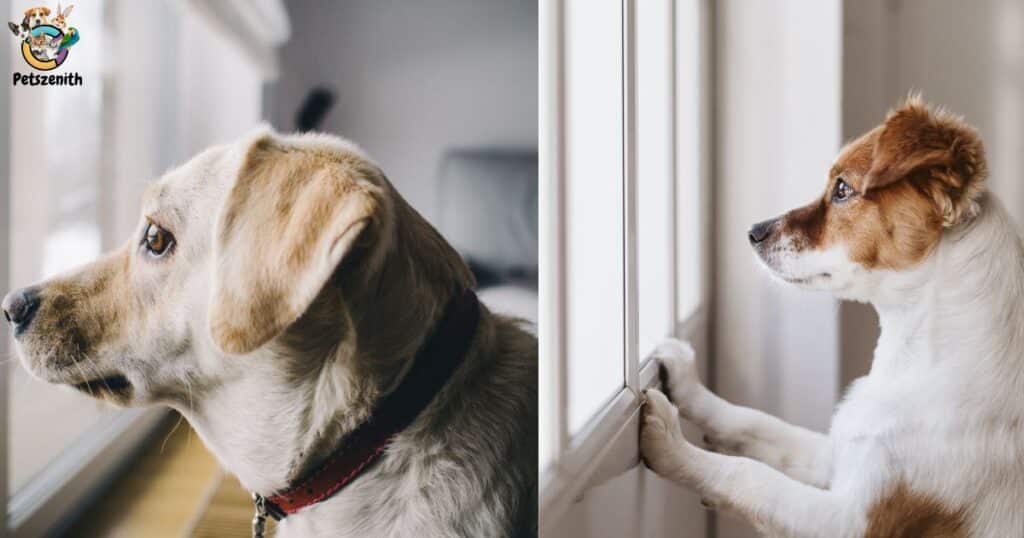
Managing your dog’s separation anxiety while you’re away requires patience and understanding. Start by crate training your dog to provide a safe space. Leave comforting items like toys and blankets in the crate. Establish a routine and gradually increase time apart to help your dog adjust. Consider seeking professional guidance for additional support.
Help Your Rescue Dog Adjust
Assisting your rescue dog in adjusting to their new environment is crucial for their well-being. Start by providing a consistent routine and a designated safe space, such as a crate. Introduce them to household members and pets gradually, using positive reinforcement to build trust. With patience and care, you can help your rescue dog feel secure and comfortable in their new home.
Stop the Feedback Loop
Stop the Feedback Loop refers to breaking the cycle of negative behaviors and reactions that perpetuate a problem. By identifying triggers and implementing positive interventions, you can disrupt the loop and promote healthier outcomes. Learn effective strategies to interrupt negative patterns and create positive change in your life.
Create a Safe Place
Creating a safe place for your rescue dog is essential for crate training success. Start by selecting a quiet, cozy spot in your home for the crate. Add soft bedding and familiar toys to make it inviting. Introduce the crate gradually, using treats and praise to build positive associations. With a comfortable and secure space, your rescue dog can feel at ease during crate training and beyond.
Build a Routine
Establishing a routine is crucial when crate training a rescue dog with separation anxiety. Consistency helps your dog feel secure and understand what to expect. Set regular times for meals, bathroom breaks, and crate sessions. Stick to the routine to create a sense of stability and comfort for your furry friend.
What should I do if my dog whines or shows distress inside the crate?
If your dog whines or shows distress inside the crate, it’s essential to address their concerns with patience and understanding. Firstly, assess if the crate is the right size and comfort level for your dog. Then, try soothing techniques like covering the crate or providing calming scents. Avoid punishing your dog and instead focus on positive reinforcement and gradual acclimatization to the crate. With time and reassurance, your dog can learn to feel more comfortable and secure in their crate.
Crate Training a Dog with Separation Anxiety Might Not Work
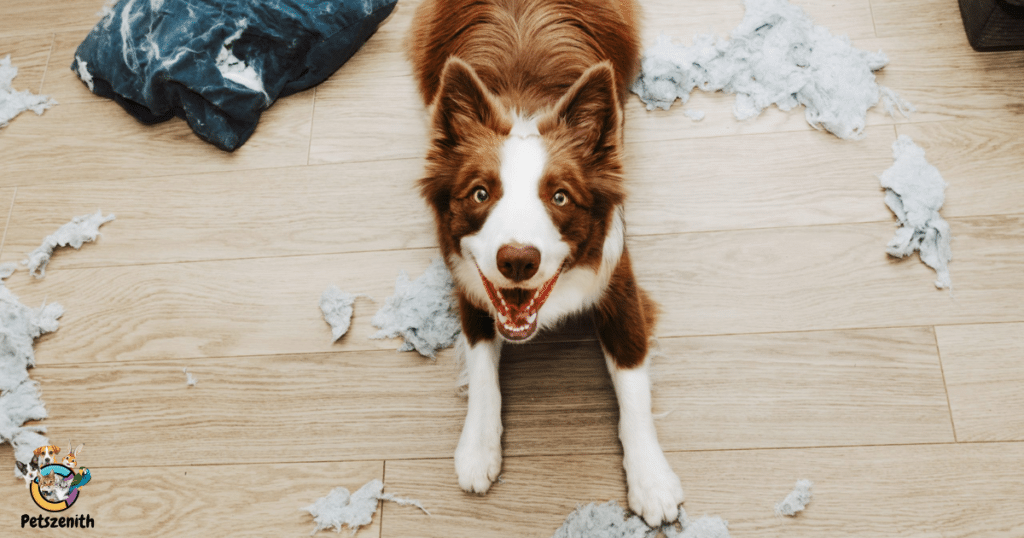
Crate training a dog with separation anxiety might not always yield immediate results. Some dogs may find it challenging to adjust to the crate, especially if they have severe anxiety issues. It’s essential to be patient and flexible, considering alternative strategies if necessary. With proper guidance and consistency, however, many dogs can eventually benefit from crate training as a tool to manage separation anxiety.
What is the best way to help a dog with separation anxiety?
When it comes to helping a dog with separation anxiety, crate training can be one of the best methods. By providing a secure space and establishing a routine, you can ease your dog’s anxiety when you’re away. Positive reinforcement and patience are key to helping your furry friend adjust and feel more comfortable on their own.
How can I get my dog used to being inside their crate?
Help your dog acclimate to their crate by introducing it gradually and positively. Start by placing treats and toys inside to encourage exploration. Associate the crate with positive experiences, like feeding and playtime. Gradually increase crate time, rewarding calm behavior. With patience and consistency, your dog will become comfortable inside their crate.
Should I punish my dog for exhibiting separation anxiety?
Punishing your dog for exhibiting separation anxiety is not recommended. Instead, focus on positive reinforcement and creating a supportive environment. Punishment can increase anxiety and worsen behavior problems. Seek professional guidance and use gentle, compassionate methods to help your dog overcome separation anxiety and feel safe in their crate.
Why Crate Train A Rescue Dog With Separation Anxiety?
Crate training a rescue dog with separation anxiety is essential for their well-being. It provides a secure environment, reducing stress and destructive behavior when left alone. By crate training, you offer your dog a safe retreat, helping them cope with separation anxiety and adjust to their new home.
Prep Tips For Success in Crate Training a Rescue Dog
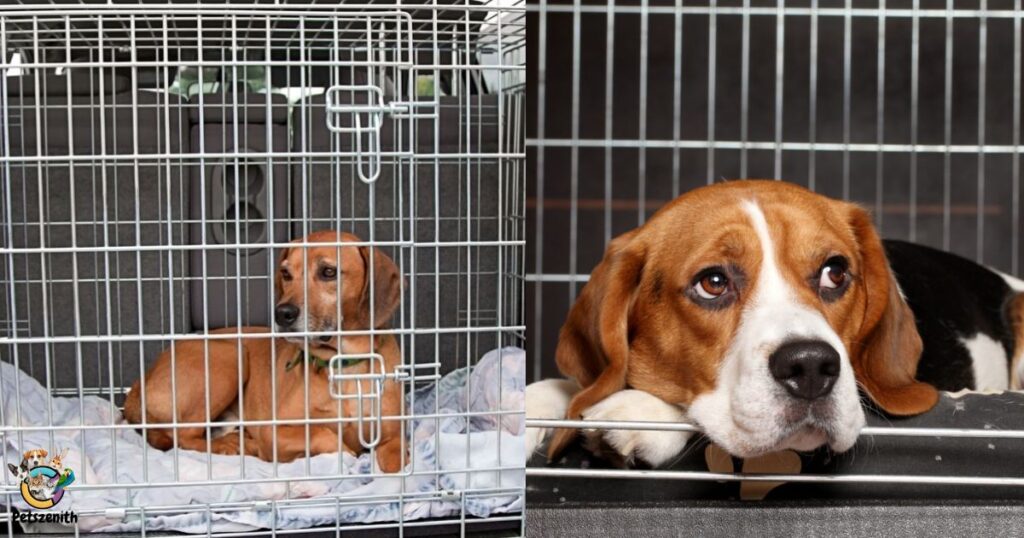
Preparing for successful crate training begins with understanding your rescue dog’s needs. Consult with your vet to address any health concerns or behavioral issues. Prioritize exercise to help your dog release excess energy before crate time. Establish yourself as a leader through positive reinforcement training techniques. Finally, create a comfortable and inviting space inside the crate with cozy bedding and familiar toys.
Talk to Your Vet
Talking to your vet is crucial when crate training a rescue dog with separation anxiety. Your vet can provide valuable guidance on your dog’s specific needs and any medical concerns. They can also offer advice on behavior management techniques and potential medication options to support your dog through the training process. Consulting with your vet ensures you have a comprehensive plan tailored to your dog’s well-being.
Exercise
Regular exercise is essential for keeping your rescue dog healthy and happy. Take your dog for daily walks or engage in active play sessions to burn off excess energy and prevent boredom. Not only does exercise improve physical fitness, but it also helps reduce anxiety and promote mental well-being. Incorporating exercise into your routine is a vital aspect of caring for your rescue dog’s overall health and happiness.
Establish Leadership
Establishing leadership with your rescue dog is crucial for successful crate training. By setting clear boundaries and providing consistent guidance, you establish yourself as the pack leader. Use positive reinforcement techniques to reinforce desired behaviors and discourage unwanted ones. Building trust and respect through leadership helps create a positive environment for crate training and overall obedience.
Training
Start by introducing the crate gradually, using positive reinforcement to associate it with comfort. Establishing a routine for crate time and avoiding punishment are crucial. With patience and consistency, you can help your rescue dog adjust and alleviate separation anxiety through effective training techniques.
Manage Other Pets
Managing other pets while crate training your rescue dog with separation anxiety is crucial for a smooth transition. Introduce the crate to all pets gradually, ensuring they associate it with positive experiences. Supervise interactions to prevent conflicts and provide separate spaces for each pet when necessary. By managing other pets effectively, you create a harmonious environment conducive to successful crate training for your rescue dog.
Frequently Asked Questions
How long does it take to crate train a rescue dog with separation anxiety?
Crate training duration varies depending on the dog’s temperament and previous experiences. Consistency and patience are key factors in successful crate training.
Can I leave my rescue dog in the crate while I’m at work?
It’s essential to gradually acclimate your dog to spending time in the crate alone. Start with short periods and gradually increase the duration as your dog becomes more comfortable.
Should I cover the crate to help my dog feel more secure?
Some dogs may feel more secure with a covered crate, while others prefer an open view. Experiment with different crate setups to see what works best for your dog.
What should I do if my dog whines or barks in the crate?
Avoid giving in to your dog’s demands or punishing them for vocalization. Instead, try to identify the underlying cause of the behavior and address it accordingly.
Can crate training exacerbate separation anxiety in rescue dogs?
When implemented correctly, crate training can help reduce separation anxiety by providing a safe and secure space for your dog. However, it’s essential to monitor your dog’s behavior and adjust the training plan as needed.
Conclusion
In conclusion, crate training offers a compassionate approach to help rescue dogs with separation anxiety adapt to their new environment. By providing a secure and comforting space, crate training fosters a sense of safety and routine for these vulnerable pets. Through gradual introduction and positive reinforcement, owners can effectively alleviate separation anxiety and promote independence in their furry companions.
Consistency and patience are key as owners navigate the crate training process, celebrating small victories and making necessary adjustments along the way. Ultimately, crate training empowers rescue dogs to overcome their fears and thrive in their forever homes. With dedication and love, owners can make a significant difference in the lives of their rescue dogs, providing them with the support and care they need to lead fulfilling lives.

Davin Connor is an experienced author with 3 years in pets writing. Known for concise, informative content, he shares expertise on pet care, behavior, and health through his engaging articles.
